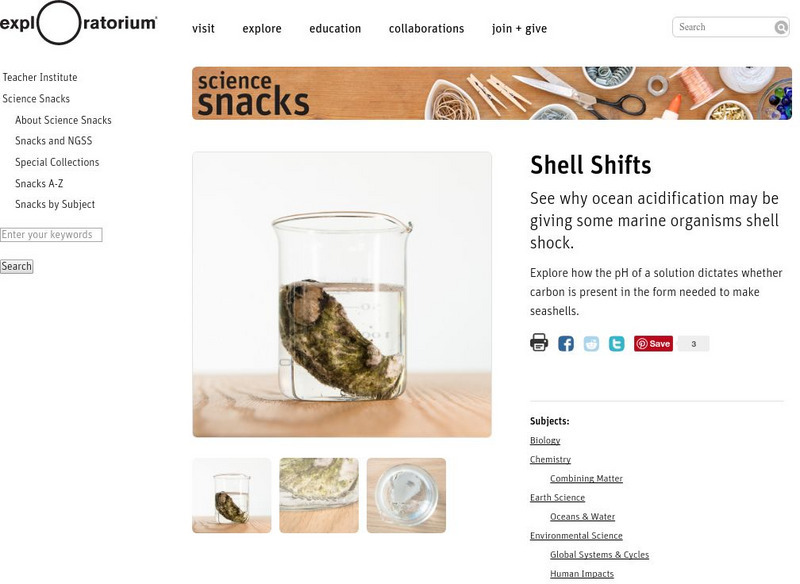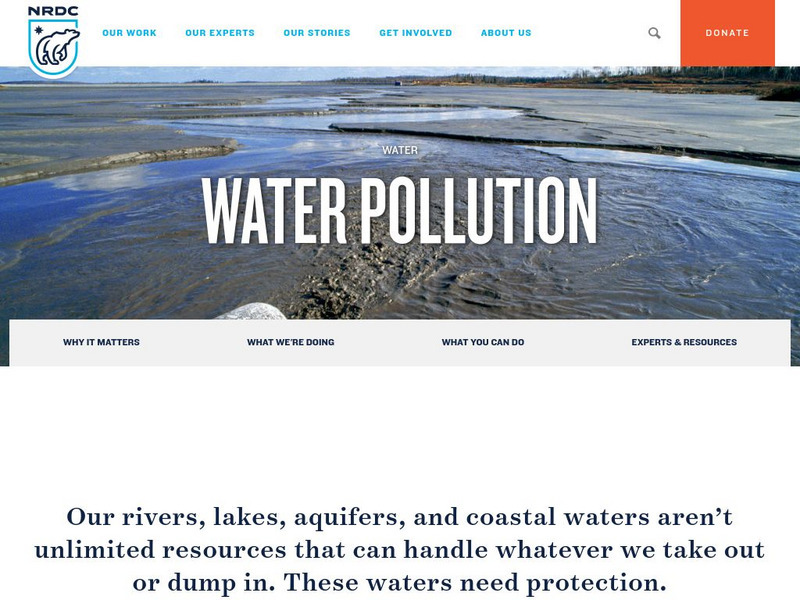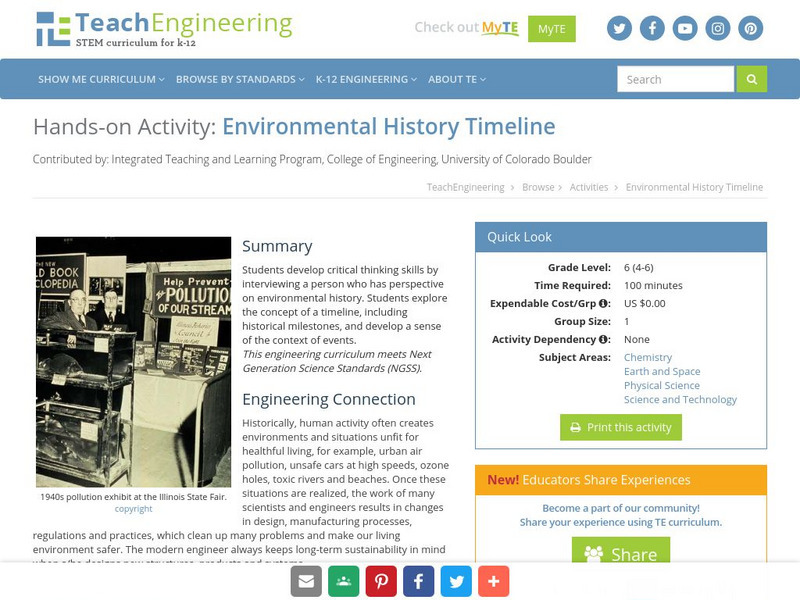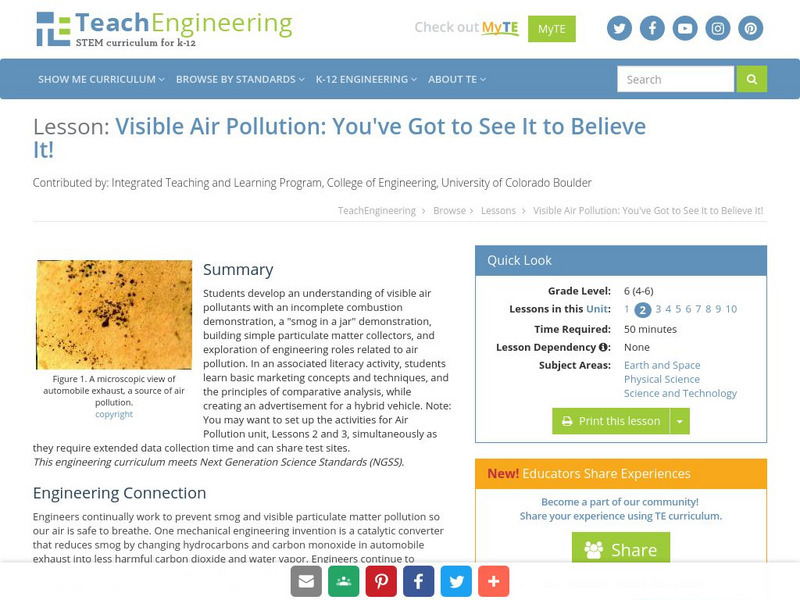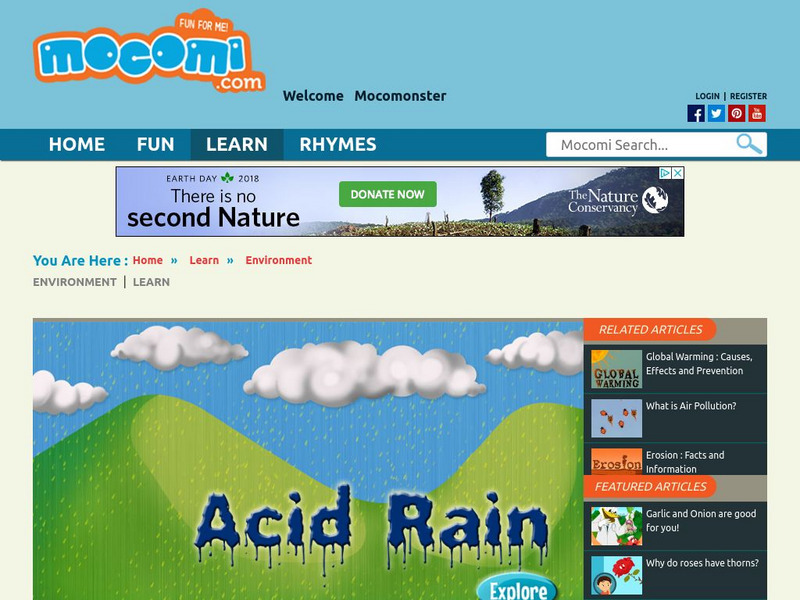Hi, what do you want to do?
Other
Household Hazardous Waste
This site contains great information about a number of household hazardous wastes and suggested methods of disposal.
Other
Odyssey of the Mind: Clean Up Your Act
Students work in teams and give a presentation depicting the causes of pollution, the ways pollution affects the environment, suggestions for reducing pollution, and ideas for making things out of trash. Click on "Activity Summaries" and...
Other
Odyssey of the Mind: Second Time Around
What is the recycling process? Why is it important to recycle? Through the activities on this page, students explore the answers to these questions, encourage others to recycle, present skits on the effects of recycling, and more.
Exploratorium
Exploratorium: Science Snacks: Shell Shifts
Investigate the damage that ocean acidification does to the shells of sea creatures.
Independence Hall Association
U.s. History: Environmental Reform
Environmental awareness in the United States became more focused upon the publication of Rachel Carson's Silent Spring. Read about student protests, presidential legislation, and a new desire to protect the environment.
Other
How to smile.org: Store Water Runoff Pollution
A demonstration that shows students how water systems are connected and the concept of non-point source pollution. Also it allows students to see how pollution on their playground could affect larger water supplies.
CK-12 Foundation
Ck 12: Earth Science: Ocean Garbage Patch
[Free Registration/Login may be required to access all resource tools.] How trash gets caught by ocean currents into certain locations.
Other
Nrdc: Clean Water and Oceans
What prompted congress to pass the Clean Water Act? Has this legislation been successful? The Natural Resources Defense Council offers information on fresh and ocean waters, pollution control, conservation, and more.
TeachEngineering
Teach Engineering: Environmental History Timeline
Students develop critical thinking skills by interviewing a person who has perspective on environmental history. Students explore the concept of a timeline, including historical milestones, and develop a sense of the context of events.
TeachEngineering
Teach Engineering: What's a Kid to Do?
Students write letters as part of an environmental action campaign. They become more aware of global environmental problems and play a part in their solution.
TeachEngineering
Teach Engineering: Stream Consciousness
During this activity, students will learn how environmental engineers monitor water quality in resource use and design. They will employ environmental indicators to assess the water quality of a nearby stream. Students will make general...
TeachEngineering
Teach Engineering: What's Down the Well?
This activity looks at physical models of groundwater and how environmental engineers determine possible sites for drinking water wells. During this activity, students will create their own groundwater well model using a coffee can and...
TeachEngineering
Teach Engineering: I Breathe What??
In this activity, students will capture and examine the particles to gain an appreciation of how much dust, pollen and other particulate matter is present in the air around them. Students will place "pollution detectors" at various...
TeachEngineering
Teach Engineering: You've Got to See It to Believe It!
Students develop an understanding of visible air pollutants with an incomplete combustion demonstration, a "smog in a jar" demonstration, building simple particulate matter collectors, and exploration of engineering roles related to air...
TeachEngineering
Teach Engineering: Not So Neutral Views
Students are introduced to acids and bases, and the environmental problem of acid rain. They explore ways to use indicators to distinguish between acids and bases. Students also conduct a simple experiment to model and discuss the...
TeachEngineering
Teach Engineering: Oil Spill
This activity will allow young scholars to explore an important role of environmental engineers: cleaning the environment. Students will learn details about the Exxon Valdez oil spill, which was one of the most publicized and studied...
TeachEngineering
Teach Engineering: How Clean Is That Water?
This lesson plan helps students understand the factors that affect water quality and the conditions that allow for different animals and plants to survive. Students will look at the effects of water quality on various water-related...
TeachEngineering
Teach Engineering: An Underground River
Groundwater is one of the largest sources of drinking water, so environmental engineers need to understand groundwater flow in order to tap into this important resource. Environmental engineers also study groundwater to predict where...
TeachEngineering
Teach Engineering: You Are What You Drink!
Contamination in drinking water sources or watersheds can negatively affect the organisms that come in contact with it. The affects can be severe - causing illness or, in some cases, even death. It is important for people to understand...
TeachEngineering
Teach Engineering: Got Dirty Air?
This lesson introduces students to the concepts of air pollution and technologies that have been developed by engineers to reduce air pollution. Students develop an understanding of visible air pollutants with an incomplete combustion...
Mocomi & Anibrain Digital Technologies
Mocomi: Acid Rain
The following interactive resource provides an explanation of what acid rain is and it highlights its causes and effects.
Other
Science Projects: Fecal Contamination of Waters
Talks about history of public health and water systems and what kind of projects are being used to improve them.
US Environmental Protection Agency
Epa: Water: Environmental Topics: Water Topics
Find out how EPA research supports efforts under the Clean Water Act and Safe Drinking Water Act.
Read Works
Read Works: Dead Zone
[Free Registration/Login Required] Students read about the "dead zone," an area in the Guld of Mexico where no fish can live due to pollution from fertilizer. A question sheet is available to help students build skills in cause and effect.








